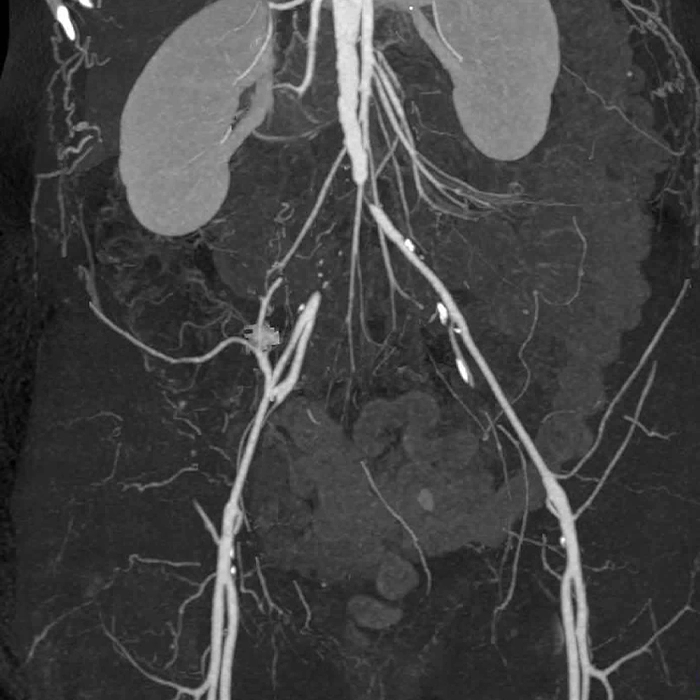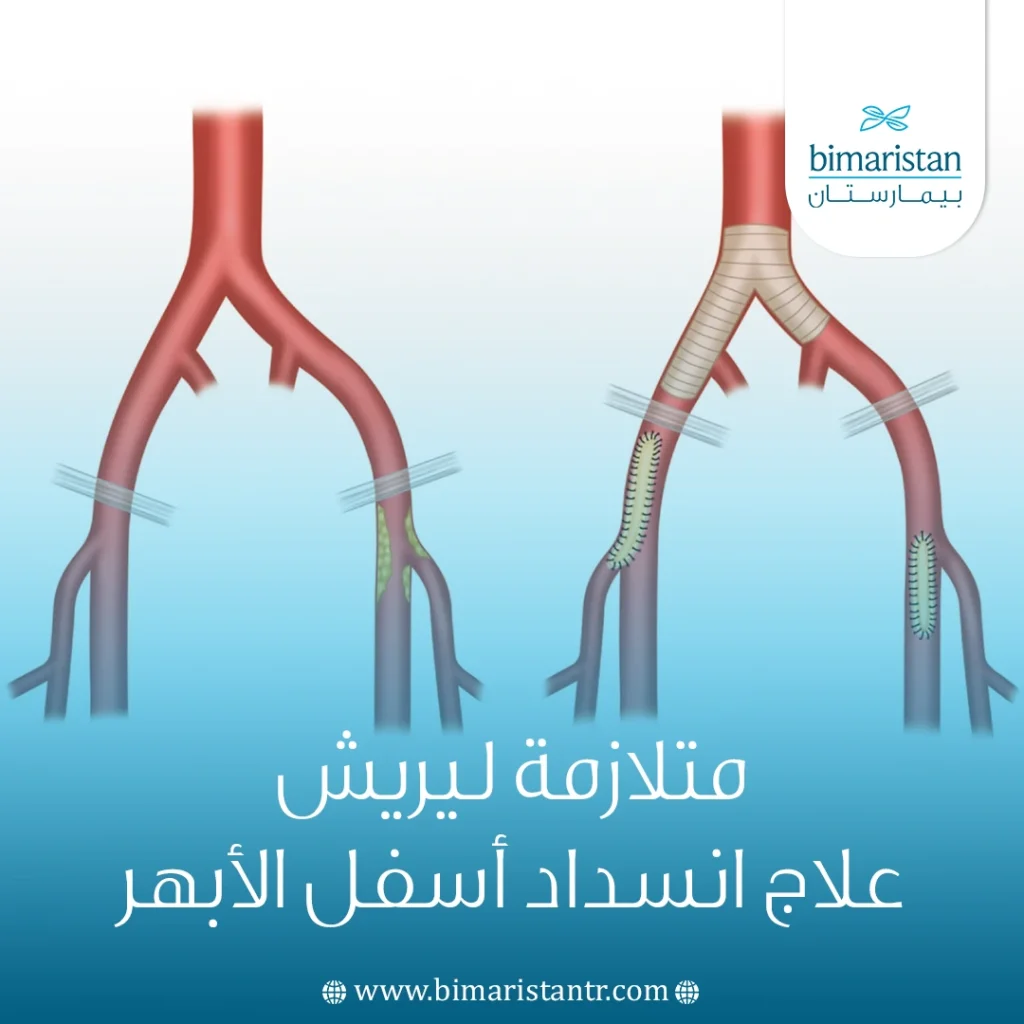متلازمة ليرش هي انسداد في الشريان الرئيسي (الشريان الأبهر) في المنطقة السفلية.
حيث يقع انسداد الأوعية الدموية في الشريان الأبهر بين مخرج الشرايين الكلوية وتفرعها (تشعبها) في شرايين الحوض.
والنتيجة هي انخفاض تدفق الدم إلى الساقين والمنطقة التناسلية، مما قد يؤدي إلى ظهور أعراض مثل شحوب الجلد في الساقين أو الألم أو الشلل أو ضعف الانتصاب.
في الأوساط المهنية، تسمى متلازمة ليريش أيضًا انسداد الأبهر تحت الكلى.
عادة ما تكون حالة مزمنة تتطور تدريجياً.
حيث يتطور ما يسمى بالأوعية الجانبية ، والتي تتجاوز الجزء المغلق وبالتالي تسمح بتدفق أقل للدم.
الأسباب المحتملة لمتلازمة ليريش
متلازمة ليرش هي انخفاض في تدفق الدم نتيجة انسداد الأوعية الدموية في الشريان الأبهر.
الشريان الأبهر هو الشريان الرئيسي الذي يبدأ من القلب والذي تتفرع منه الشرايين الكبيرة.
يمكن أن ينتج انسداد الشريان الأبهر السفلي عن تصلب الشرايين.
تصلب الشرايين هو مرض يصيب الشرايين حيث تتزايد الترسبات تدريجياً والتي تضيّق المقطع العرضي للأوعية الدموية.
تصلب الشرايين، بدوره، ينتج من قبل عدة عوامل مثل: التدخين وارتفاع ضغط الدم والوزن الزائد جداً وارتفاع نسبة الدهون في الدم إضافة إلى قلة النشاط البدني أو مرض السكري (مرض السكري من النوع الثاني).
أعراض متلازمة ليرش (انسداد الشريان الأبهر السفلي)
تسبب متلازمة ليرش عدم الراحة في الأجزاء السفلية من الجسم.
حيث يمكن أن يحدث الألم في الساقين (الفخذين بشكل أساسي) والأرداف وكذلك الوركين.
غالبًا ما تكون الأرجل شاحبة اللون وباردة.
النبض على الفخذين وفي الفخذ ضعيف أو غائب.
قد يشعر المريض بالخدر والضعف في الساقين ، أو في بعض الأحيان بالشلل.
كما تقل مسافة المشي التي يمكن للشخص المصاب أن يقطعها دون ألم.
يشار إلى هذا أيضًا بشكل مناسب باسم المشي المتقطع: يستمر المصابون بالتوقف ليبدو وكأنهم ينظرون إلى نوافذ المتاجر، لكن هذا في الحقيقة يسمح لأرجلهم بالاسترخاء. المصطلح الطبي له هو العرج المتقطع.
يمكن أيضًا أن تصبح اضطرابات التئام الجروح في الساقين ملحوظة بشكل كبير.
يمكن أن يحدث خلل في المثانة البولية أو الأمعاء أيضًا في متلازمة ليريش.
عند الرجال ، يمكن أن يؤثر انخفاض تدفق الدم على القضيب ويمكن أن يحدث ضعف في الانتصاب.
سبب آخر محتمل لمتلازمة ليريش هو انسداد الشريان الأبهر في المنطقة السفلية بسبب جلطة دموية (انسداد أو خثرة).
علاوة على ذلك ، فإن التهاب الأوعية الدموية يمكن أن يؤدي إلى متلازمة ليريش.
تشخيص انسداد الأبهر في المنطقة السفلية في تركيا
يجري الطبيب مقابلة فحص مع المريض (سوابق المريض). يكتشف الأعراض وكذلك الأمراض السابقة المحتملة. يتم فحص المريض جسديًا ويقوم الطبيب على وجه الخصوص بتقييم حالة الساقين وبعض الأجزاء الأخرى من الجسم.
يتم الكشف عن متلازمة ليرش باستخدام تقنيات التصوير. بالموجات فوق الصوتية. “تخطيط الصدى الدوبلري Doppler echocardiography” هو فحص بالموجات فوق الصوتية يمكن استخدامه لتحديد تدفق الدم في الأوعية الدموية بدقة.
أيضًا بالامكان التشخيص بواسطة تصوير الأوعية بمصور الاوعية Digital subtraction angiography حيث.يعتبر DSA (ويدعى أيضاً تصوير الأوعية بالطرح الرقمي) مناسبًا بشكل خاص كطريقة يتم فيها عرض الجزء الداخلي فقط من الأوعية الدموية.ت

يعتبر التصوير الوعائي باستخدام الرنين المغناطيسي (MRA) طريقة أخرى مناسبة تمامًا وهو طريقة تصوير متطورة جداً لكن يعيبها تكلفتها العالية.
التشخيص التفريقي
يمكن للعديد من حالات الأوعية الدموية أن تحاكي أعراض متلازمة ليريش ويجب أخذها في الاعتبار عند التشخيص التفريقي.
قد يتسبب تسلخ الشرايين ، وخاصة في الشرايين الحرقفية ، في حدوث العرج وغياب نبضات الفخذ التي تحاكي أعراض متلازمة ليريش.
قد يكون وجود ألم الراحة والمسار الزمني المحدد لظهور الأعراض مفيدًا في تحديد الأمراض الكامنة بالتزامن مع التصوير بالموجات فوق الصوتية وتصوير الشرايين.
هناك الكثير من مرضى الأوعية المعرضين لخطر متزايد للتسلخ والانسداد الحاد.
لا يُرى إقفار الأطراف الحرج في كثير من الأحيان في متلازمة ليريش، حيث أن مساره الزمني يسمح بتطور الأوعية الدموية الجانبية.
تشمل علامات نقص تروية الأطراف الحرجة:
ظهور ألم مفاجئ في الطرف المصاب، وتنمل، وشحوب أو برودة، ونبضات متضائلة أو غير موجودة.
قد ينتج الانسداد عن تجلط الدم أو الصمات من منطقة الأوعية الدموية القريبة أو التسلخ.
علاج متلازمة ليريش في تركيا
لعلاج متلازمة ليريش، يلزم إجراء جراحة لإزالة الانسداد الأبهري.
كقاعدة عامة، يتم استخدام بديل خاص للأوعية يُعرف باسم الطرف الاصطناعي على شكل حرف Y أو الأطراف الاصطناعية ذات التشعب (أيضًا: المجازة الشريانية الفخذية أو المجازة الحرقفية).
البدلة الوعائية لها شكل حرف Y مقلوب، حيث يتم سد الجزء السفلي من الشريان الأبهر والأجزاء العلوية من الشرايين الأربية.

المادة المستخدمة لاستبدال الأوعية الدموية مصنوعة من البلاستيك المرن.
يتم خياطة هذا الطعم بين الشريان الأبهر والشرايين الأربية بحيث يكون هناك اتصال وعائي.
تتم هذه العملية عن طريق شق في البطن تحت تأثير التخدير العام.
في حالات نادرة جدًا ، يجب إنشاء مجازة جانبية بين الشريان الموجود أسفل عظم الترقوة والشرايين الأربية (المجازة الإبطية ثنائية الفخذ). يمكن الإشارة إلى هذه المجازة الطويلة في حالة حدوث تغيرات شديدة في تصلب الشرايين في المنطقة المصابة.
يمكن أحيانًا علاج متلازمة ليريش الناتجة عن تجلط الدم (الخثرة) التي نشأت هناك عن طريق كشط جدار الوعاء الدموي الداخلي. يُطلق على العملية الخاصة بهذا الإجراء استئصال باطنة الشريان أو استئصال باطنة الشريان الخثاري.
إذا كان الانسداد ناتجًا عن جلطة دموية (صمة) هاجرت إلى المنطقة ، فيمكن محاولة إزالتها (استئصال الصمة).
يمكن القيام بذلك عن طريق الفتح المباشر بواسطة القسطرة (قسطرة فوغارتي) يمكن بواسطتها سحب الجلطة الدموية.
في ظل ظروف معينة ، يمكن أيضًا إجراء العلاج باستخدام قسطرة وعائية تقليدية في إجراء يسمى رأب الوعاء (PTA) ، حيث يتم توسيع تضيق الوعاء الدموي بواسطة بالون يتم إدخاله في الوعاء الدموي من خلال القسطرة ثم نفخه. بالإضافة إلى ذلك ، يمكن استخدام ما يسمى بالدعامة ، وهي شبكة سلكية تُبقي الوعاء مفتوحًا من الداخل.
المضاعفات ممكنة مع هذه العمليات. على سبيل المثال ، لا يمكن استبعاد النزيف والالتهابات. بعد استعادة تدفق الدم ، يمكن أن تحدث متلازمة ما بعد الإقفار – من الممكن احتباس الماء (الوذمة) وانتشار المواد الضارة من الجزء الذي تم إمداد الدم بالدم مرة أخرى.
سيقوم الطبيب بموازنة أسباب الإجراء مقابل المخاطر ؛ وعادة ما يكون الإجراء مبررًا.
تُعطى مضادات التخثر عمومًا كعلاج دوائي.
المضاعفات المحتملة
يعتمد التكهن وفرص نجاح العملية على العديد من العوامل. بشكل عام ، يمكن القول أن التوقعات عادة ما تكون مواتية ، لأن المسار المزمن يعني أن التدخل مع التحضير الصحيح ممكن وعادة لا يتعين تنفيذه في حالة الطوارئ.

